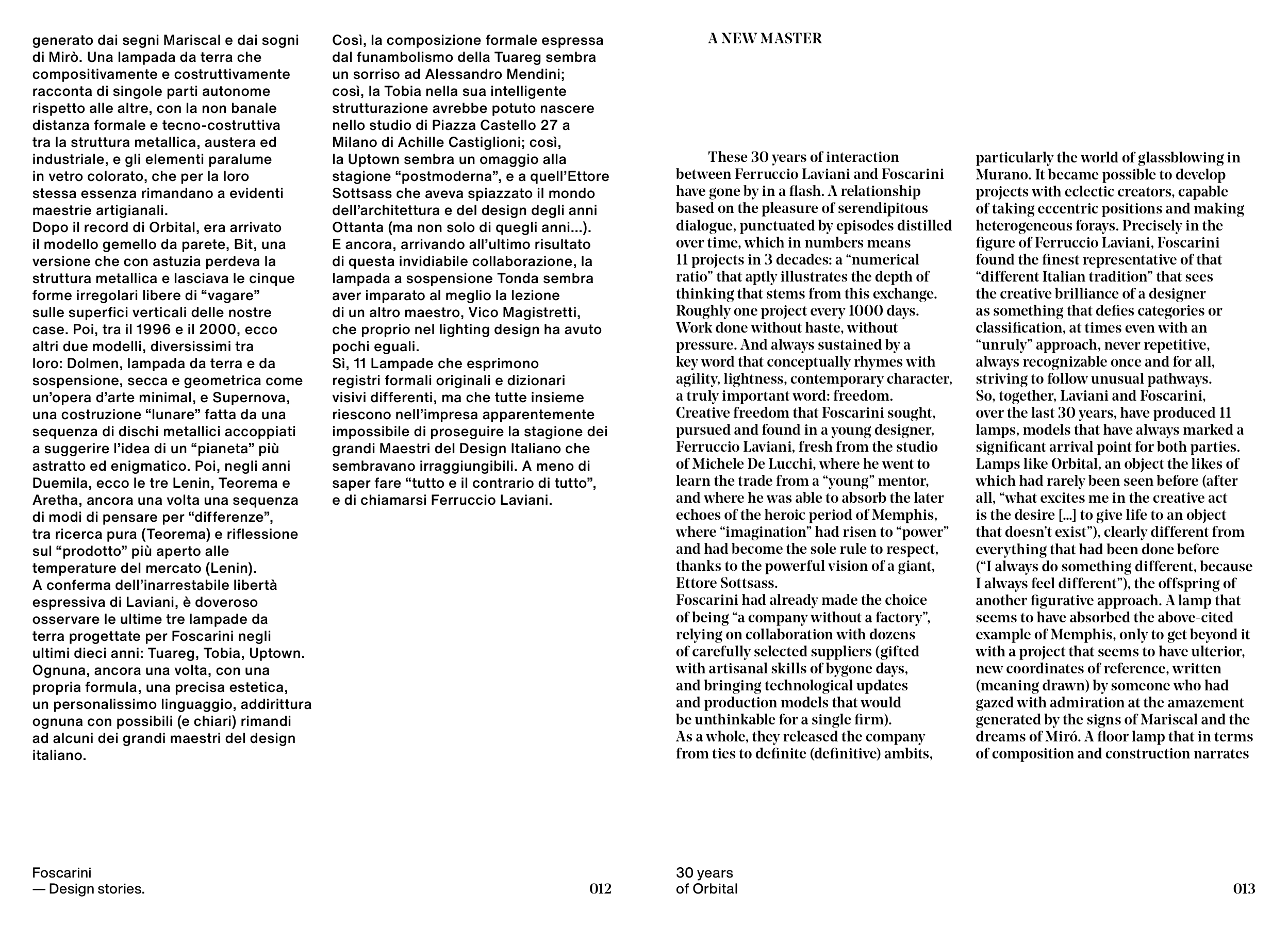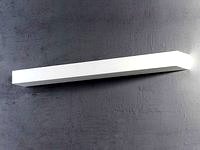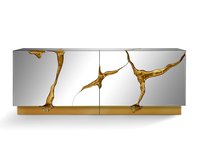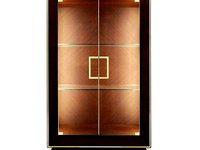012
Foscarini
— Design stories.
generato dai segni Mariscal e dai sogni
di Mirò. Una lampada da terra che
compositivamente e costruttivamente
racconta di singole parti autonome
rispetto alle altre, con la non banale
distanza formale e tecno-costruttiva
tra la struttura metallica, austera ed
industriale, e gli elementi paralume
in vetro colorato, che per la loro
stessa essenza rimandano a evidenti
maestrie artigianali.
Dopo il record di Orbital, era arrivato
il modello gemello da parete, Bit, una
versione che con astuzia perdeva la
struttura metallica e lasciava le cinque
forme irregolari libere di “vagare”
sulle superfici verticali delle nostre
case. Poi, tra il 1996 e il 2000, ecco
altri due modelli, diversissimi tra
loro: Dolmen, lampada da terra e da
sospensione, secca e geometrica come
un’opera d’arte minimal, e Supernova,
una costruzione “lunare” fatta da una
sequenza di dischi metallici accoppiati
a suggerire l’idea di un “pianeta” più
astratto ed enigmatico. Poi, negli anni
Duemila, ecco le tre Lenin, Teorema e
Aretha, ancora una volta una sequenza
di modi di pensare per “differenze”,
tra ricerca pura (Teorema) e riflessione
sul “prodotto” più aperto alle
temperature del mercato (Lenin).
A conferma dell’inarrestabile libertà
espressiva di Laviani, è doveroso
osservare le ultime tre lampade da
terra progettate per Foscarini negli
ultimi dieci anni: Tuareg, Tobia, Uptown.
Ognuna, ancora una volta, con una
propria formula, una precisa estetica,
un personalissimo linguaggio, addirittura
ognuna con possibili (e chiari) rimandi
ad alcuni dei grandi maestri del design
italiano.
Così, la composizione formale espressa
dal funambolismo della Tuareg sembra
un sorriso ad Alessandro Mendini;
così, la Tobia nella sua intelligente
strutturazione avrebbe potuto nascere
nello studio di Piazza Castello 27 a
Milano di Achille Castiglioni; così,
la Uptown sembra un omaggio alla
stagione “postmoderna”, e a quell’Ettore
Sottsass che aveva spiazzato il mondo
dell’architettura e del design degli anni
Ottanta (ma non solo di quegli anni…).
E ancora, arrivando all’ultimo risultato
di questa invidiabile collaborazione, la
lampada a sospensione Tonda sembra
aver imparato al meglio la lezione
di un altro maestro, Vico Magistretti,
che proprio nel lighting design ha avuto
pochi eguali.
Sì, 11 Lampade che esprimono
registri formali originali e dizionari
visivi differenti, ma che tutte insieme
riescono nell’impresa apparentemente
impossibile di proseguire la stagione dei
grandi Maestri del Design Italiano che
sembravano irraggiungibili. A meno di
saper fare “tutto e il contrario di tutto”,
e di chiamarsi Ferruccio Laviani.
013
30 years
of Orbital
These 30 years of interaction
between Ferruccio Laviani and Foscarini
have gone by in a flash. A relationship
based on the pleasure of serendipitous
dialogue, punctuated by episodes distilled
over time, which in numbers means
11 projects in 3 decades: a “numerical
ratio” that aptly illustrates the depth of
thinking that stems from this exchange.
Roughly one project every 1000 days.
Work done without haste, without
pressure. And always sustained by a
key word that conceptually rhymes with
agility, lightness, contemporary character,
a truly important word: freedom.
Creative freedom that Foscarini sought,
pursued and found in a young designer,
Ferruccio Laviani, fresh from the studio
of Michele De Lucchi, where he went to
learn the trade from a “young” mentor,
and where he was able to absorb the later
echoes of the heroic period of Memphis,
where “imagination” had risen to “power”
and had become the sole rule to respect,
thanks to the powerful vision of a giant,
Ettore Sottsass.
Foscarini had already made the choice
of being “a company without a factory”,
relying on collaboration with dozens
of carefully selected suppliers (gifted
with artisanal skills of bygone days,
and bringing technological updates
and production models that would
be unthinkable for a single firm).
As a whole, they released the company
from ties to definite (definitive) ambits,
particularly the world of glassblowing in
Murano. It became possible to develop
projects with eclectic creators, capable
of taking eccentric positions and making
heterogeneous forays. Precisely in the
figure of Ferruccio Laviani, Foscarini
found the finest representative of that
“different Italian tradition” that sees
the creative brilliance of a designer
as something that defies categories or
classification, at times even with an
“unruly” approach, never repetitive,
always recognizable once and for all,
striving to follow unusual pathways.
So, together, Laviani and Foscarini,
over the last 30 years, have produced 11
lamps, models that have always marked a
significant arrival point for both parties.
Lamps like Orbital, an object the likes of
which had rarely been seen before (after
all, “what excites me in the creative act
is the desire […] to give life to an object
that doesn’t exist”), clearly different from
everything that had been done before
(“I always do something different, because
I always feel different”), the offspring of
another figurative approach. A lamp that
seems to have absorbed the above-cited
example of Memphis, only to get beyond it
with a project that seems to have ulterior,
new coordinates of reference, written
(meaning drawn) by someone who had
gazed with admiration at the amazement
generated by the signs of Mariscal and the
dreams of Miró. A floor lamp that in terms
of composition and construction narrates
A NEW MASTER







